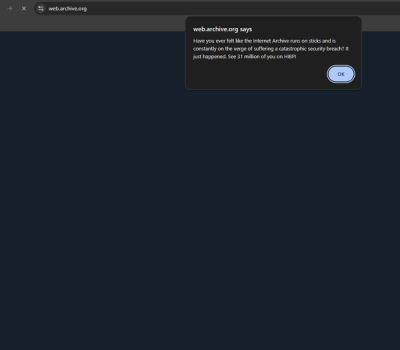
Security News
Internet Archive Hacked, 31 Million Record Compromised
The Internet Archive's "Wayback Machine" has been hacked and defaced, with 31 millions records compromised.
The Ozone class framework contains enhanced class support to ease the development of object-oriented javascript applications in an ES5 environment. Another alternative to get a better class support to use ES6 classes and compilers like Babel, Traceur or TypeScript until native ES6 support arrives.
npm install o3
bower install o3
The framework succeeded the tests on
by the usage of npm scripts under win7 x64.
I wasn't able to test the framework by Opera since the Karma launcher is buggy, so I decided not to support Opera.
I used Yadda to write BDD tests. I used Karma with Browserify to test the framework in browsers.
On pre-ES5 environments there will be bugs in the Class module due to pre-ES5 enumeration and the lack of some ES5 methods, so pre-ES5 environments are not supported.
An ES5 capable environment is required with
Object.createObject.defineProperty, Object.getOwnPropertyDescriptor, Object.prototype.hasOwnProperty, etc.Array.prototype.forEachIn this documentation I used the framework as follows:
var o3 = require("o3"),
Class = o3.Class;
You can extend native classes by calling the Class() function.
var UserError = Class(Error, {
prototype: {
message: "blah",
constructor: function UserError() {
Error.captureStackTrace(this, this.constructor);
}
}
});
An alternative to call Class.extend() with the Ancestor as the context. The Class() function uses this in the background.
var UserError = Class.extend.call(Error, {
prototype: {
message: "blah",
constructor: function UserError() {
Error.captureStackTrace(this, this.constructor);
}
}
});
You can use Class.extend() by any other class, not just by native classes.
var Ancestor = Class(Object, {
prototype: {
a: 1,
b: 2
}
});
var Descendant = Class.extend.call(Ancestor, {
prototype: {
c: 3
}
});
Or you can simply add it as a static method, so you don't have to pass context any time you want to use it. The only drawback, that this static method will be inherited as well.
var Ancestor = Class(Object, {
extend: Class.extend,
prototype: {
a: 1,
b: 2
}
});
var Descendant = Ancestor.extend({
prototype: {
c: 3
}
});
You can inherit the extend() method and other utility methods from the Class class. Probably this is the simplest solution if you need the Class API and you don't need to inherit from special native classes like Error.
var Ancestor = Class.extend({
prototype: {
a: 1,
b: 2
}
});
var Descendant = Ancestor.extend({
prototype: {
c: 3
}
});
The static extend() method uses the clone() and merge() utility methods to inherit from the ancestor and add properties from the config.
var MyClass = Class.clone.call(Object, function MyClass(){
// ...
});
Class.merge.call(MyClass, {
prototype: {
x: 1,
y: 2
}
});
Or with utility methods.
var MyClass = Class.clone(function MyClass() {
// ...
}).merge({
prototype: {
x: 1,
y: 2
}
});
You can fill in missing properties with the usage of absorb.
var MyClass = Class(SomeAncestor, {...});
Class.absorb.call(MyClass, Class);
MyClass.merge({...});
For example if you don't have Class methods and your class already has an ancestor, then you can use absorb() to add Class methods.
You can pass your custom constructor as a config option by creating the class.
var MyClass = Class(Object, {
prototype: {
constructor: function () {
// ...
}
}
});
Or you can pass a static factory method to create your custom constructor.
var MyClass = Class(Object, {
factory: function () {
return function () {
// ...
}
}
});
By inheritance the constructors of the descendant classes will be automatically created as well.
var Ancestor = Class(Object, {
factory: function () {
return function () {
// ...
}
}
});
var Descendant = Class(Ancestor, {});
You don't need to pass anything if you need a noop function as constructor. The Class.factory() will create a noop constructor by default.
var MyClass = Class(Object, {});
In fact you don't need to pass any arguments to the Class function if you need an empty class inheriting from the Object native class.
var MyClass = Class();
The default factory calls the build() and init() methods if they are given.
var MyClass = Class({
prototype: {
build: function (options) {
console.log("build", options);
},
init: function (options) {
console.log("init", options);
}
}
});
var my = new MyClass({a: 1, b: 2});
// build {a: 1, b: 2}
// init {a: 1, b: 2}
var my2 = my.clone({c: 3});
// build {c: 3}
var MyClass2 = MyClass.extend({}, [{d: 4}]);
// build {d: 4}
Ofc. you can create a new instance in the javascript way.
var MyClass = Class();
var my = new MyClass();
You can create a new instance by cloning the prototype of the class.
var MyClass = Class();
var my = Class.prototype.clone.call(MyClass.prototype);
Or you can inherit the utility methods to make this easier.
var MyClass = Class.extend();
var my = MyClass.prototype.clone();
You can clone an existing instance with the clone method.
var MyClass = Class.extend();
var my = MyClass.prototype.clone();
var my2 = my.clone();
Be aware that this is prototypal inheritance with Object.create(), so the inherited properties won't be enumerable.
The clone() method calls the build() method on the new instance if it is given.
You can use the same behavior both by cloning and by creating a new instance using the constructor
var MyClass = Class.extend({
lastIndex: 0,
prototype: {
index: undefined,
constructor: function MyClass() {
return MyClass.prototype.clone();
},
clone: function () {
var instance = Class.prototype.clone.call(this);
instance.index = ++MyClass.lastIndex;
return instance;
}
}
});
var my1 = new MyClass();
var my2 = MyClass.prototype.clone();
var my3 = my1.clone();
var my4 = my2.clone();
Be aware that this way the constructor will drop the instance created with the new operator.
Be aware that the clone() method is used by inheritance, so creating the prototype of a descendant class will use the clone() method as well.
var Descendant = MyClass.clone(function Descendant() {
return Descendant.prototype.clone();
});
var my5 = Descendant.prototype;
var my6 = new Descendant();
// ...
You can use absorb() to set default values after configuration.
var MyClass = Class.extend({
prototype: {
constructor: function (config) {
var theDefaults = {
// ...
};
this.merge(config);
this.absorb(theDefaults);
}
}
});
You can use merge() to set default values before configuration.
var MyClass = Class.extend({
prototype: {
constructor: function (config) {
var theDefaults = {
// ...
};
this.merge(theDefaults);
this.merge(config);
}
}
});
You can use inheritance to set default values on class level.
var MyClass = Class.extend({
prototype: {
aProperty: defaultValue,
// ...
constructor: function (config) {
this.merge(config);
}
}
});
MIT - 2015 Jánszky László Lajos
FAQs
o3 - Javascript Class Framework
The npm package o3 receives a total of 50,144 weekly downloads. As such, o3 popularity was classified as popular.
We found that o3 demonstrated a not healthy version release cadence and project activity because the last version was released a year ago. It has 1 open source maintainer collaborating on the project.
Did you know?

Socket for GitHub automatically highlights issues in each pull request and monitors the health of all your open source dependencies. Discover the contents of your packages and block harmful activity before you install or update your dependencies.

Security News
The Internet Archive's "Wayback Machine" has been hacked and defaced, with 31 millions records compromised.

Security News
TC39 is meeting in Tokyo this week and they have approved nearly a dozen proposals to advance to the next stages.

Security News
Our threat research team breaks down two malicious npm packages designed to exploit developer trust, steal your data, and destroy data on your machine.